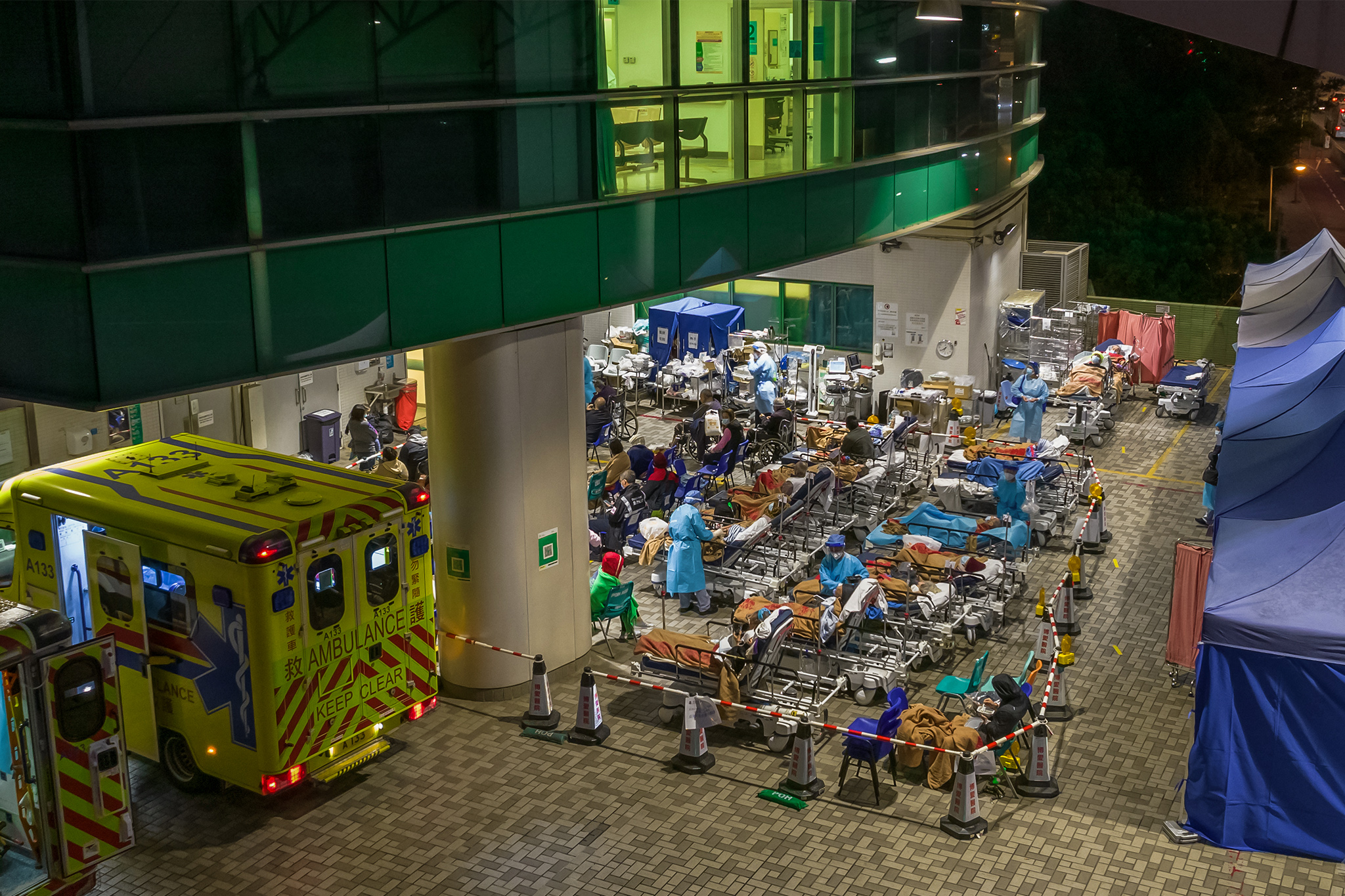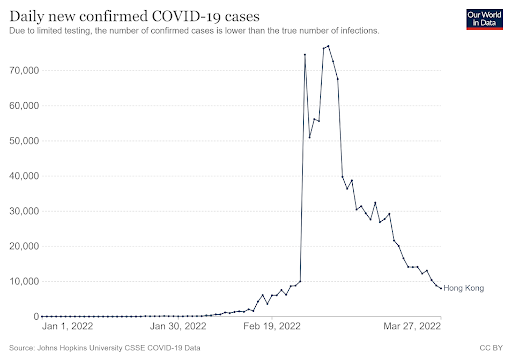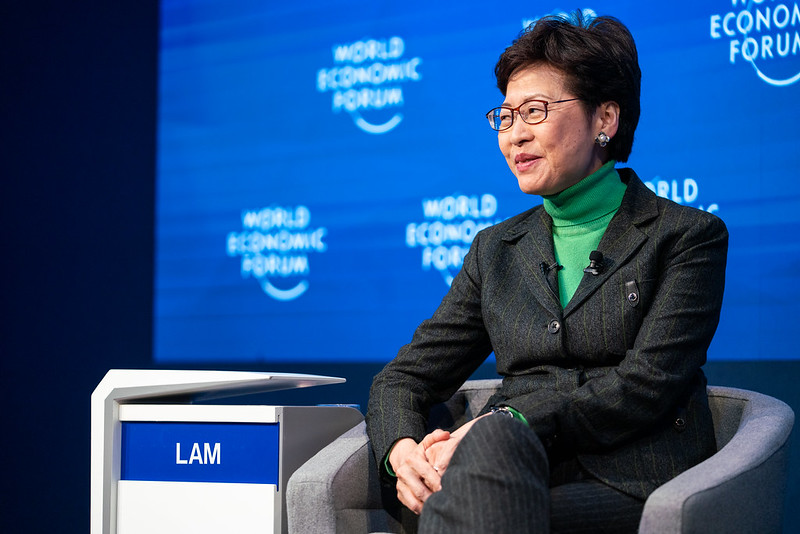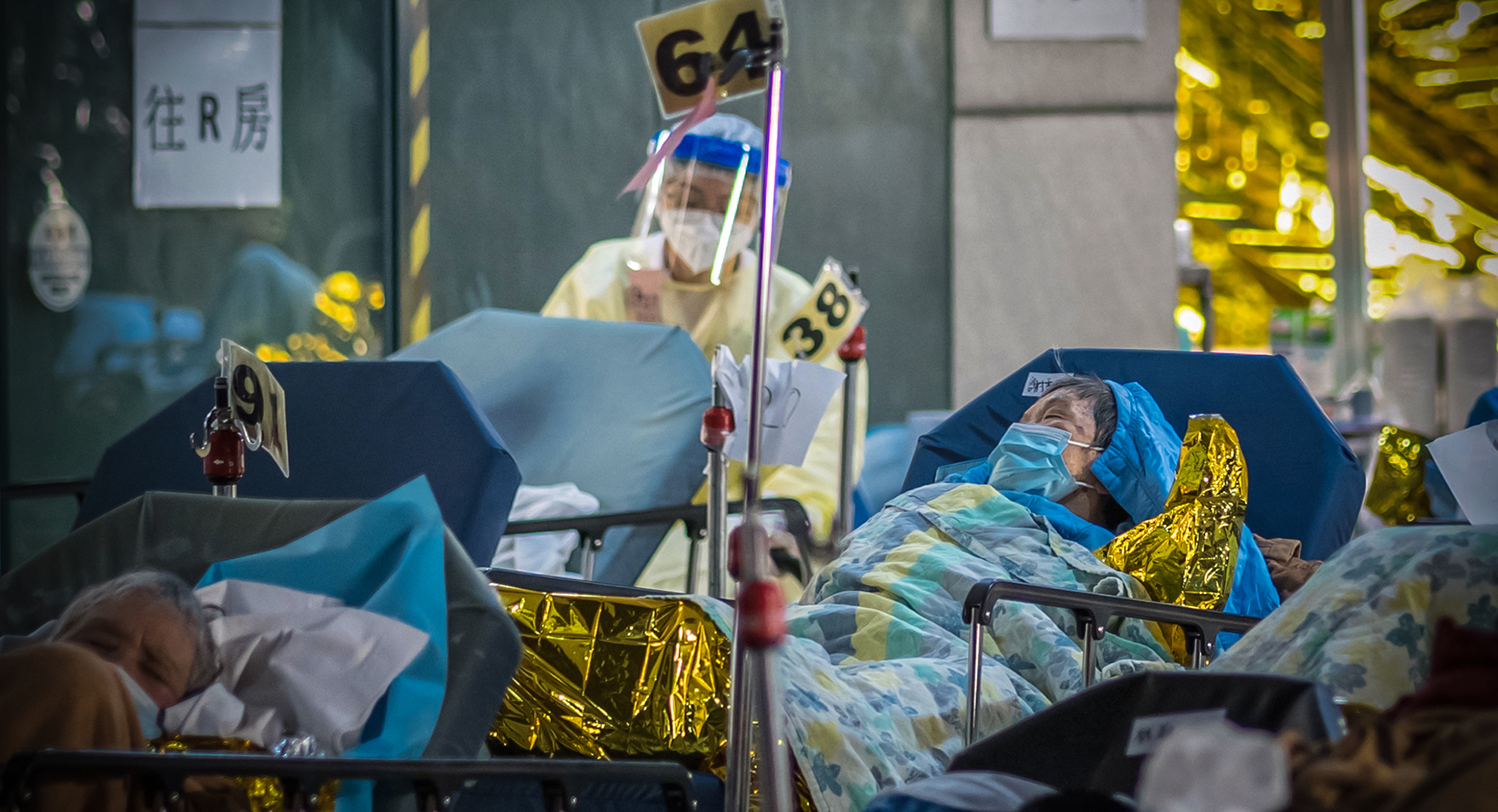The fifth (and by far the most serious) wave of COVID-19 infections began in December 2021 in Hong Kong. It rapidly increased up until the end of January 2022, and thereafter cases and deaths continued to climb. By 3 March, daily infections had reached over 76,000 (over 1 percent of Hong Kong’s population) – a peak in Hong Kong since the pandemic began.
According to official sources, as of 29 March, the fifth wave in Hong Kong had already led to over 1.1 million cases. On 28 March, Chief Executive Carrie Lam admitted that “common sense should tell us that there must be more than a million cases.” She then pointed to the example of the Kwong Fuk Estate that is under quarantine, where 25% of the residents in its four buildings tested positive. Projecting that to the whole of Hong Kong would suggests there are around 1.8 million cases of infection. Meanwhile, on 22 March, Hong Kong University Dean of Medicine and government advisor, Gabriel Leung, estimated that the real number of infections in Hong Kong to be around 4.4 million.
As of 29 March, the number of deaths from the fifth wave has reached 7,358 – about 1 in 1,000 of the city’s residents. Yahoo HK reported on 16 March that, due to the lockdown of roads to Shenzhen, Hong Kong’s capacity for storing cadavers would be exceeded by the 200-300 deaths occurring each day. There is a shortage of caskets, while crematoria around Hong Kong have been operating 24-7.
 As of 29 March, the number of deaths from the fifth wave has reached 7,358 – about 1 in 1,000 of the city’s residents / Image: Studio Incendo, Facebook
As of 29 March, the number of deaths from the fifth wave has reached 7,358 – about 1 in 1,000 of the city’s residents / Image: Studio Incendo, Facebook
Besides the crisis in the healthcare system, the pandemic has slammed the economy. Many businesses have been severely impacted, while many are outright bankrupt. Mannings, the biggest drugstore chain in Hong Kong, had to shut dozens of its sites. In February, a restaurant owner in Hong Kong, Syed Asim Hussain, told the BBC that his revenue had plummeted to 5 to 10 percent of normal. The chairman of the Hong Kong Federation of Restaurants and Related Trades, Simon Wong Ka-wo, indicated on 15 January that, due to restrictions on dinner services, the restaurant industry suffered a 40 percent drop in business.
Of course, the working class is made to pay a severe cost for these crises. Simon Wong claimed in March that over 3,000 restaurants had closed down. Over 60,000 workers face short or long-term unemployment. Hong Kong’s unemployment rate has increased from 3.9 to 4.5 percent. On 23 March, the Hong Kong government initiated its 10,000 HKD cash relief programme for the unemployed. Over 100,000 people applied on the first day. Three days later, the number of applications had risen to 160,000.
The pandemic is also causing waves of people to either buy up goods, or else leave Hong Kong in panic. At the beginning of March, after a rumour began circulating that the Hong Kong government might institute a lockdown, droves of people cleared up vegetables, fruit, meat, medicine, and other goods from store shelves. In some markets, sale restrictions were imposed by the state. The supermarket chain ParknShop limited its sale of rice, canned food, noodles, eggs, tissues and medicine, with every customer restricted to purchasing five units of each of these items.
According to data from the government’s Immigration Department, Hong Kong is also undergoing its biggest wave of emigration since the pandemic began, with over 70,000 people leaving in February alone.
As we can see, the crisis brought forth by the pandemic is not simply a public health crisis. Rather, it is a crisis of the capitalist system. The virus is a fearsome disease, indeed, with long-lasting implications. But the crisis wracking the world is not caused by the virus in itself, or even the incompetence of the public health system. It is caused by the very inability of the capitalist system to handle such a pandemic.
‘Dynamic zero’, or herd immunity?
Since the outbreak, politicians have been ceaselessly bickering over the ‘zero covid’ versus ‘herd immunity’ strategies. How should Marxists view these debates? At the end of the day, the society in which we live operates on the basis of a capitalist mode of production. In the face of a serious public health crisis, safeguarding the lives and health of workers and ordinary peoples is not the priority of the capitalist state. Rather, the profits of the bourgeoisie reign supreme.
Tactical differences in how countries have handled the pandemic are merely differences over how to secure the short and long-term profits of each country’s ruling class. Under capitalism, the laissez-faire ‘herd immunity’ approach amounts to the defense of short-term profits via a policy of large-scale social murder. The bourgeoisie in the United States have murdered one million people by this route. On the other hand, a ‘zero covid’ policy, which aims at getting the working class back to its daily toil as quickly as possible following outbreaks, increasingly requires more and more brutal lockdowns and quarantines. Under the present conditions, most countries have practically given up on pandemic control measures. As such, those countries that fared better in the previous period through stronger control measures can no longer ward off the virus alone.
 According to official sources, as of 29 March, the fifth wave in Hong Kong had already led to over 1.1 million cases / Image: our world in data
According to official sources, as of 29 March, the fifth wave in Hong Kong had already led to over 1.1 million cases / Image: our world in data
But the policies of the Hong Kong government have created an awkward hybrid situation. As an international port city and the third biggest financial hub in the world, the government has assured the world since February that the city will never lockdown! Meanwhile, measures to universally test, as proposed by pro-Beijing politicians, were ultimately rejected by the government, which cited a lack of personnel and that such a policy is too late to apply anyway.
It seems that the majority of the bourgeois in Hong Kong would prefer not to go down the route of a lockdown. Carrie Lam explained that she “cares deeply for [the maintenance of] Hong Kong’s status as an international financial center” in a press conference on 18 March, when challenged by a journalist over the growing discontent of several financial institutions towards the government. Yet she paradoxically emphasised at the same time that Hong Kong would insist on a “Dynamic Zero-Covid” approach, with some restrictions imposed short of a full lockdown.
The results have now demonstrated that the “Dynamic Zero” approach in Hong Kong has diverged greatly from the “Zero-Covid” approach taken up in mainland China, and in practice it is the same policy as the completely useless and defeatist approach that the West has taken up. Laughably, when asked about the efficacy of her “Dynamic Zero” policy on 21 March, Lam dismissed the question by saying she did not wish to dwell on particular terms.
The crisis of Hong Kong’s bourgeois dictatorship
China’s state media Xinhua summarized the reasons for the present wave of infection in Hong Kong thusly on March 3rd:
“According to David Lam of the LegCo’s medical constituency, the reasons for the accelerating rate of infection in this fifth wave are firstly the high population density, the fact that most people live in small spaces, especially those who live in public housing or rental apartments. Since people live close to one another, infections then spread easily…”
 In the face of a serious public health crisis, safeguarding the lives and health of workers and ordinary peoples is not the priority of the capitalist state. Rather, the profits of the bourgeoisie reign supreme / Image: WEF, Flickr
In the face of a serious public health crisis, safeguarding the lives and health of workers and ordinary peoples is not the priority of the capitalist state. Rather, the profits of the bourgeoisie reign supreme / Image: WEF, Flickr
This prompts the question: isn’t the fact that most people have to live in tiny spaces the very product of this “capitalist haven”, which the CCP maintains in Hong Kong, in which the economy is dominated by finance and real estate interests, which force the masses to live in ever shrinking quarters? Under the profit-driven capitalist system, capital seeking to make a return ends up in speculative avenues like real estate, driving prices upward. House prices have gone up, whilst wage growth has failed to keep up. Countless people are therefore being forced into harsher and harsher living conditions. The pandemic only brought these contradictions to the surface and has exacerbated them.
How come no administration in Hong Kong has attempted to solve the problems facing the masses since the city’s return to China? The answer is simple. The state itself exists to defend the interests of the bourgeoisie in Hong Kong. In many ways, the dictatorship of the bourgeoisie in Hong Kong is more apparent than in bourgeois democracies in other parts of the world. Setting aside the authoritarian rule by the British colonial government of the past, the present-day system in Hong Kong bears this out: de facto, the Chief Executives are appointed by Beijing; The Legislative Council (LegCo), which has real power, has 30 functional constituency seats, and 40 seats formed by the electoral commission, all of which are fully controlled by the capitalist class. Only 20 seats are selected on the basis of the votes from the masses, who are by default excluded from directly participating in the city’s politics.
In 2019, the election of the more symbolic District Council saw anti-Beijing bourgeois liberals sweep the board as the masses cast their vote in protest against Beijing. Yet shortly thereafter, the National Security Laws led to practically all of them being expelled from the legislative bodies. At the same time, all the mass organisations, independent trade unions, and anti-Beijing media were forced to disband following the implementation of this law. The Beijing-controlled Hong Kong Federation of Trade Unions meanwhile, shamelessly and consistently sided with the capitalists in repressing the working masses, showing in practice that it is completely incapable of fighting for the rights of the ordinary workers at the bottom. These developments only make the dictatorship of the bourgeois class more naked in Hong Kong.
The pandemic has plunged the regime in Hong Kong into crisis once again. Trust in the government is falling lower. A recent poll conducted by Hong Kong Public Opinion Research Institute showed that over 72 percent of Hongkongers are dissatisfied with the government’s handling of the pandemic – a 15 point drop compared to last month, representing the lowest point in two years. Over 74 percent of Hongkongers are dissatisfied with the state of the economy. The crisis in faith in the government is more than evident. But as many in the media have pointed out, there will probably be a sixth wave of infections after the current one. All of this chaos is the result of the crisis of the world capitalist system. Capitalism itself is the source of these horrors, which are without end.
What is the way out?
Since the end of the 2019 mass movement, the masses in Hong Kong have been ravaged by both the virus, and the Beijing-controlled government. Now that the virus has finally breached into the general population, the preexisting contradictions of Hong Kong capitalism have been brought to the fore by the virus. So too has the impotence of the state. These will become factors in preparing a new wave of struggle.
As we have explained repeatedly: the painful experiences of recent years have shown the masses that there is an unbridgeable chasm between their interests, and those of the people in power and of the bourgeois liberals. The masses now need a workers’ party that can link these developments to the need for a revolutionary overthrow of capitalism and the construction of a socialist society. Such a party would strive to link up the workers and youth of Hong Kong with those of mainland China to overthrow capitalism in both places and establish a genuine worker’s democracy.

